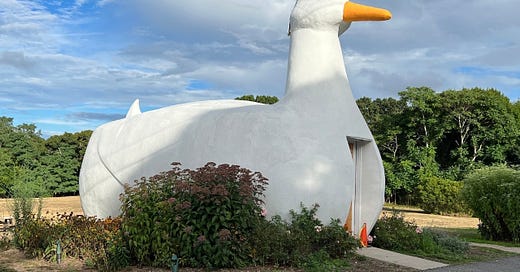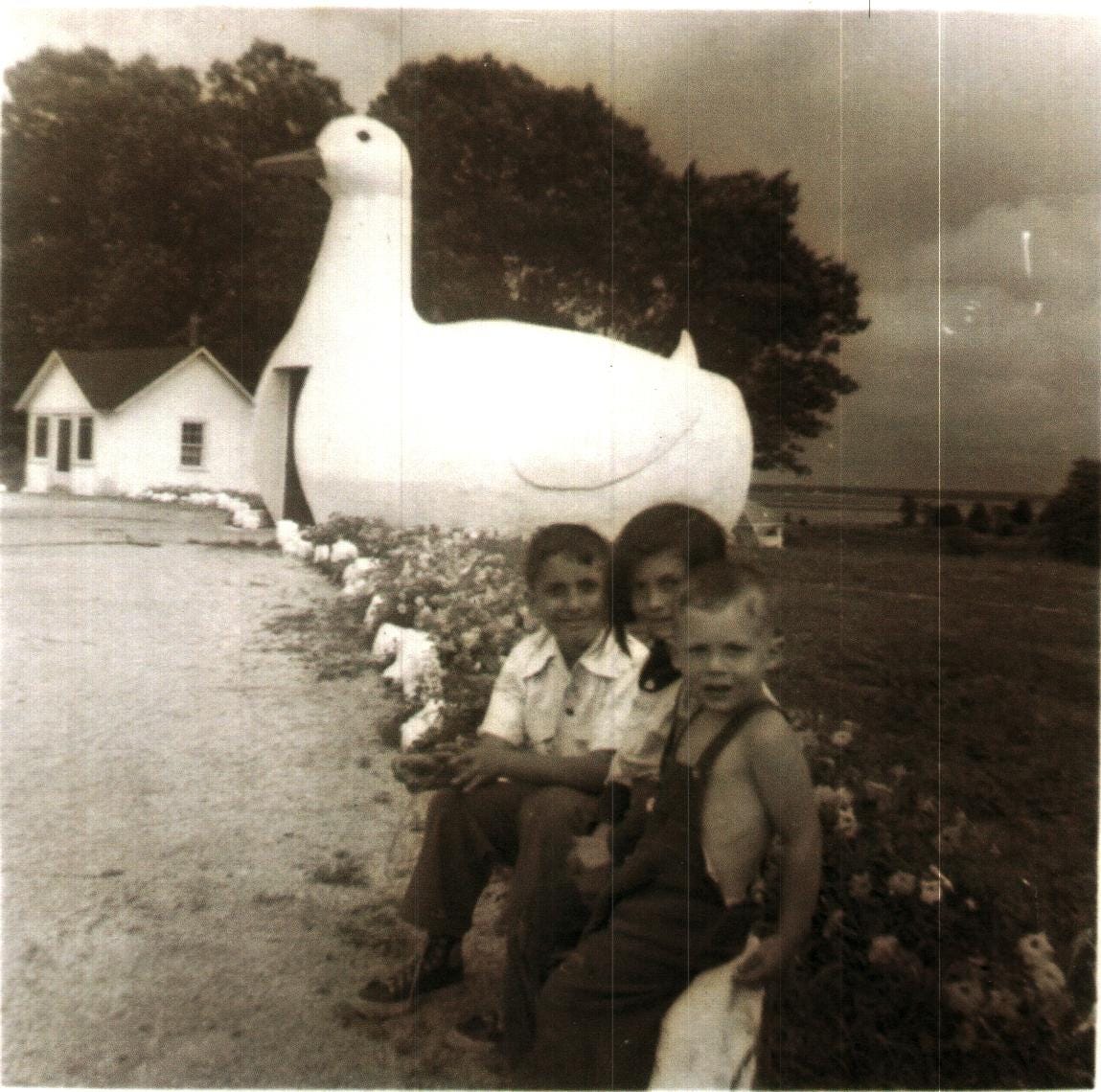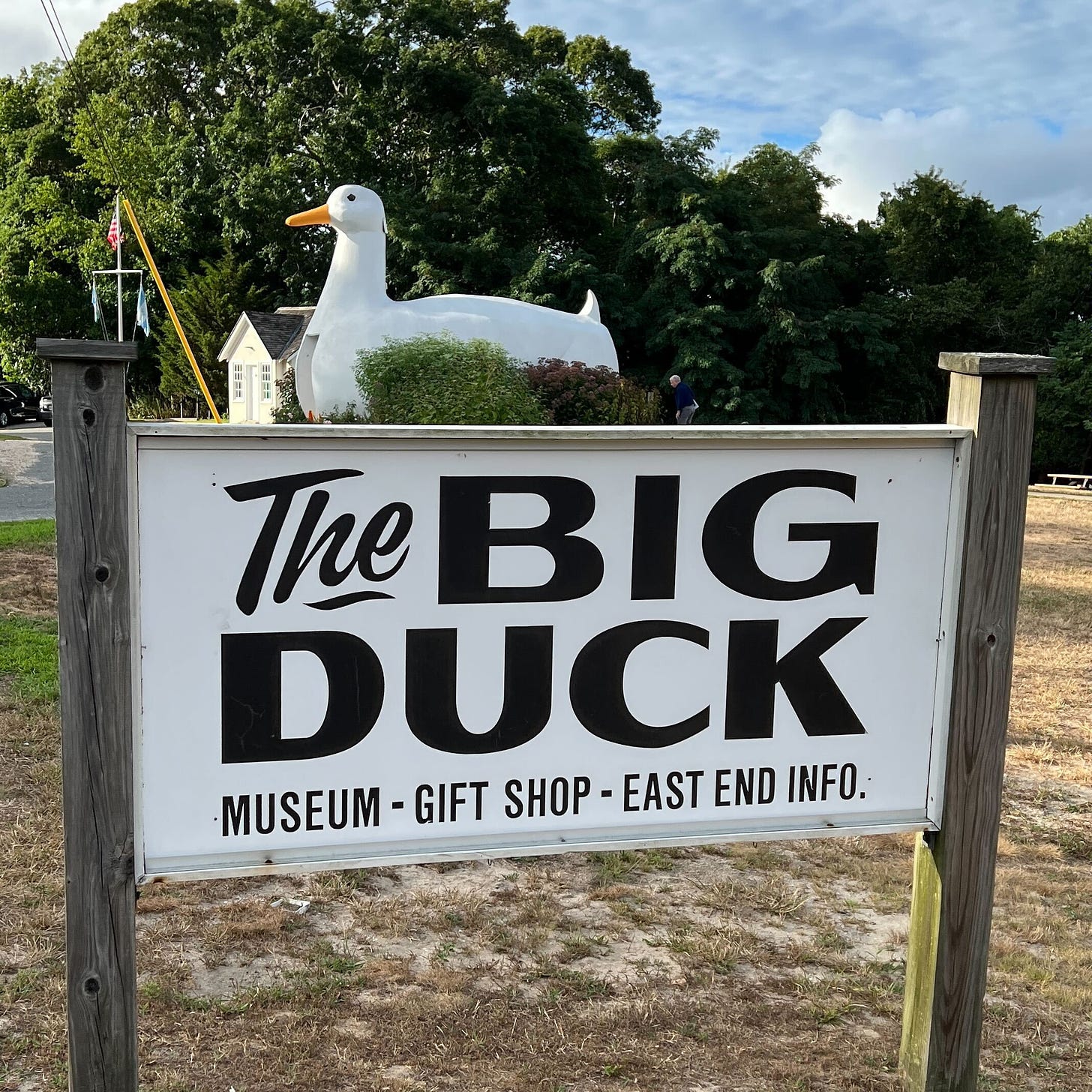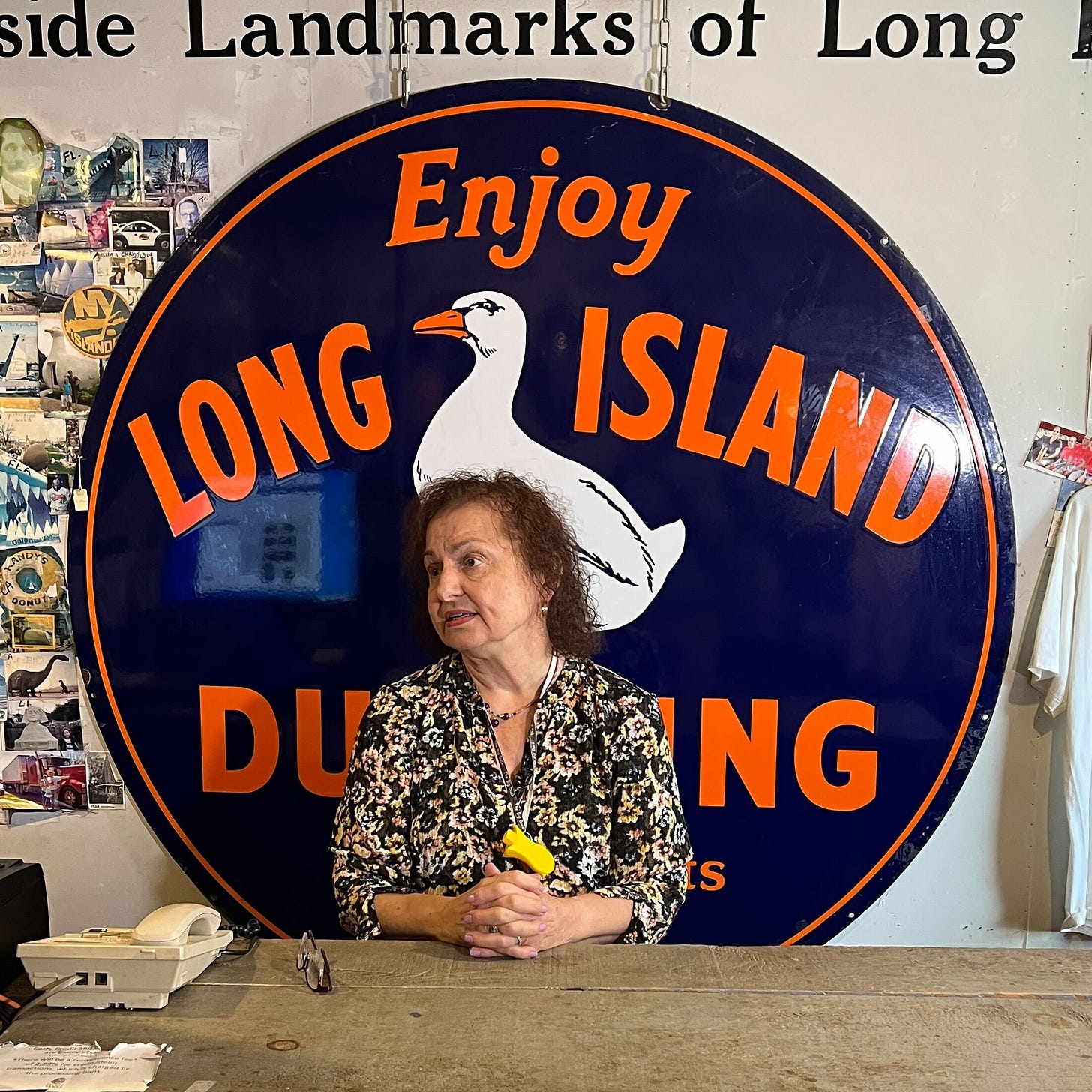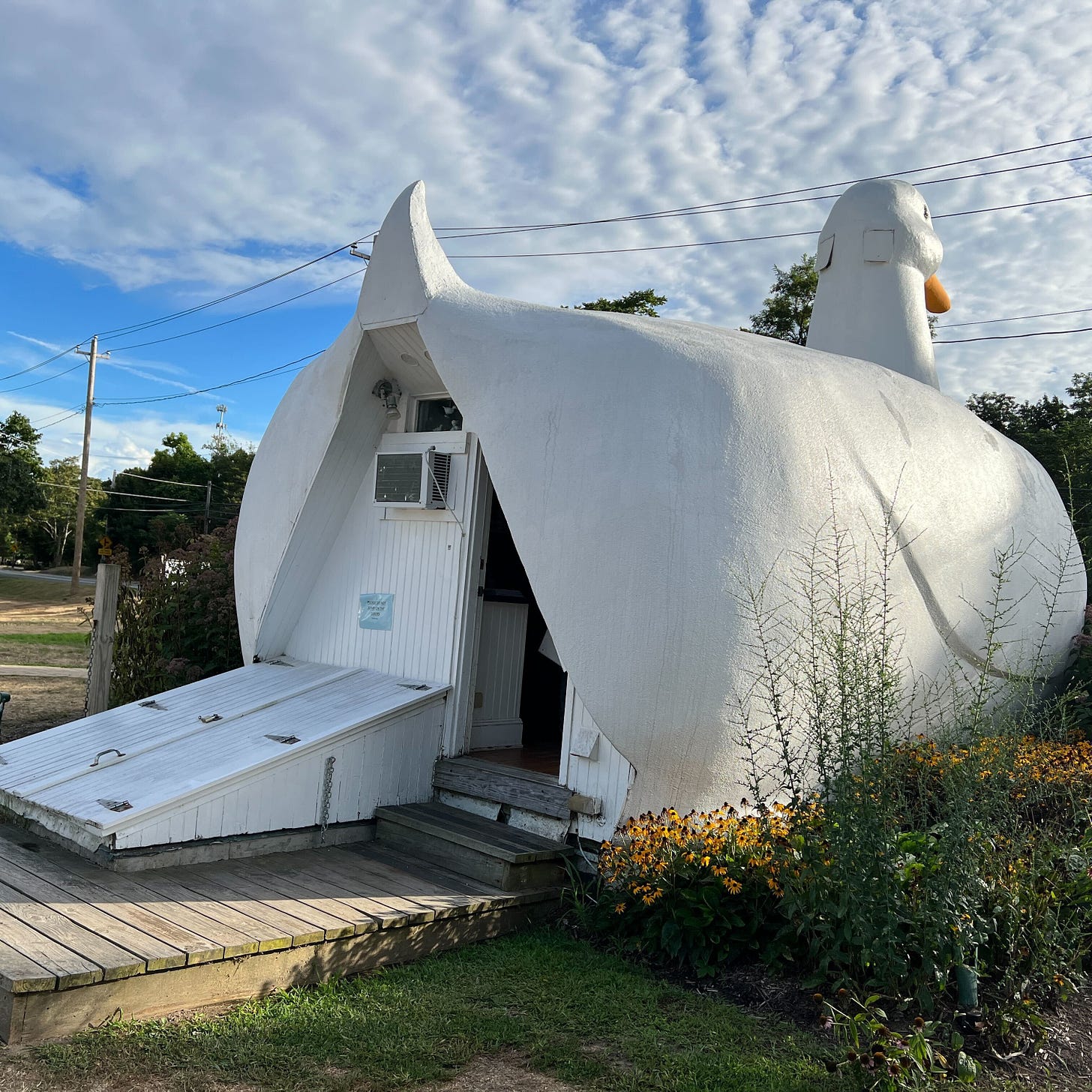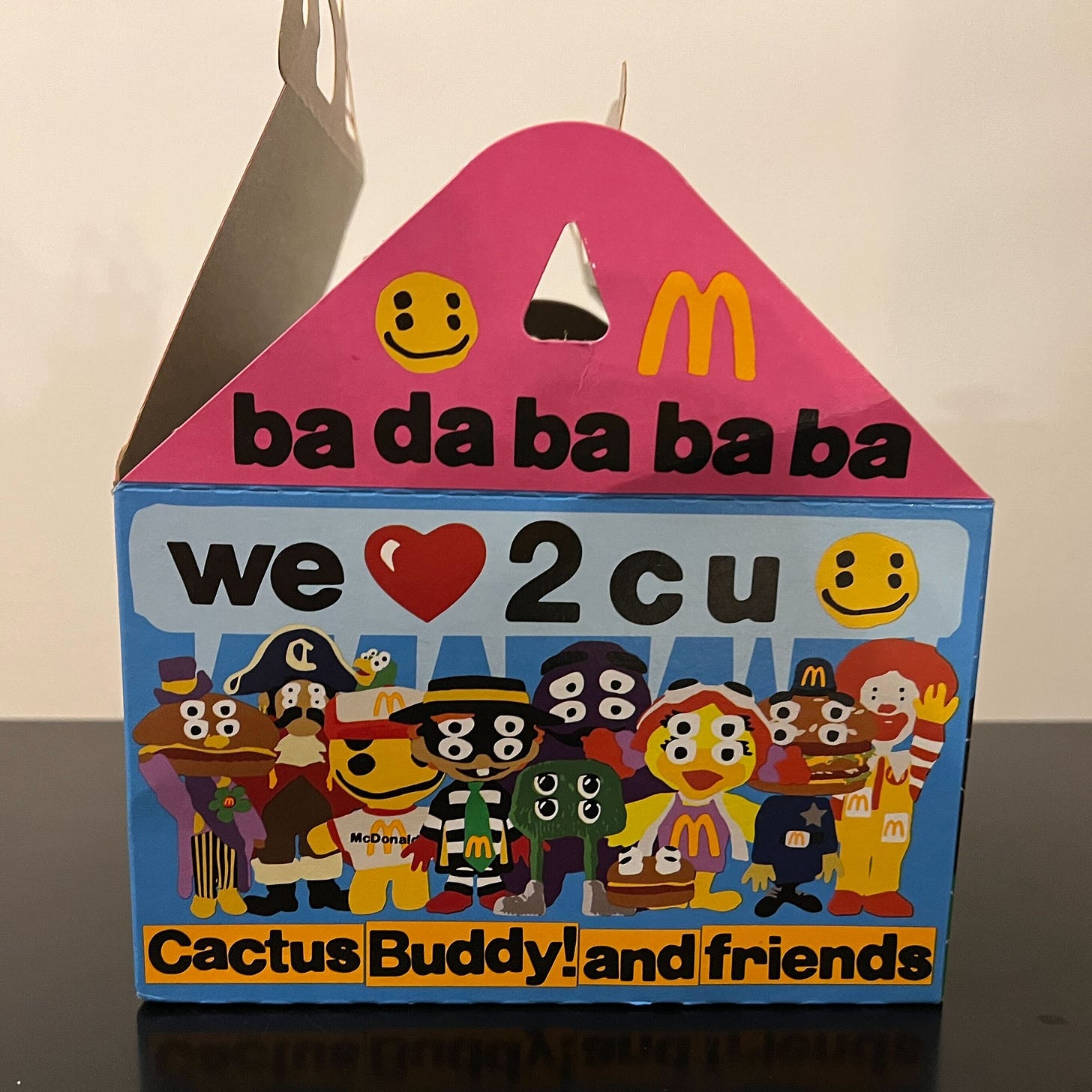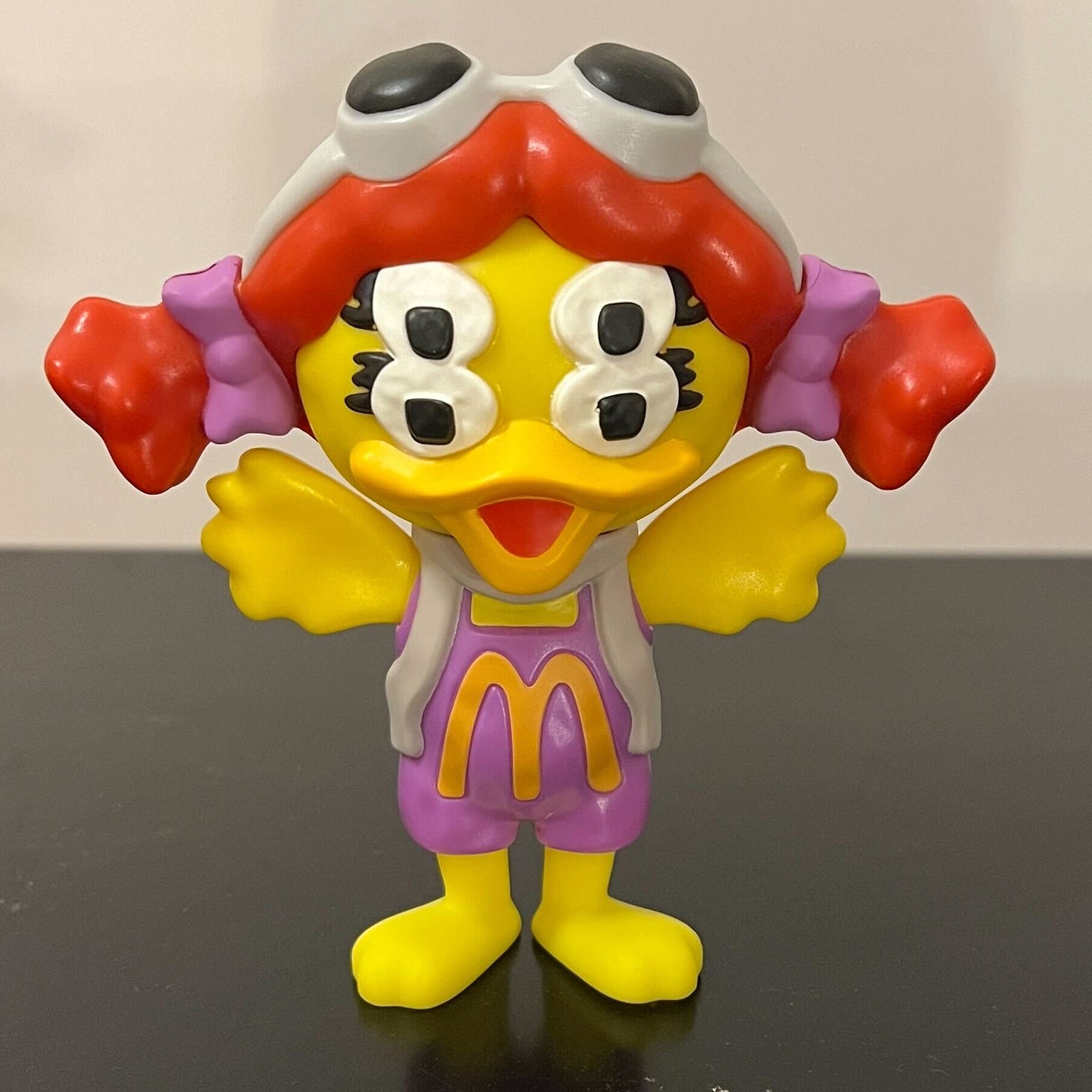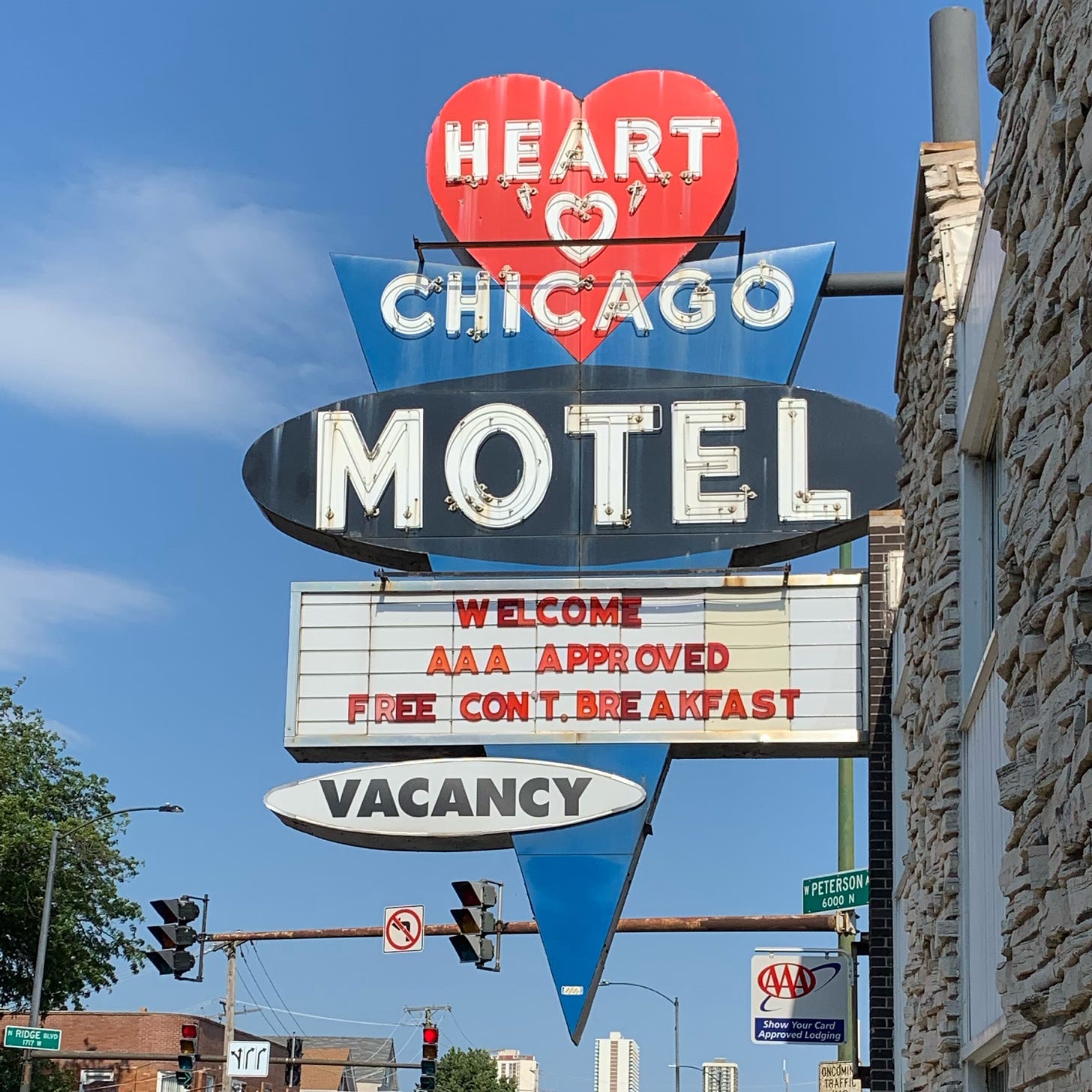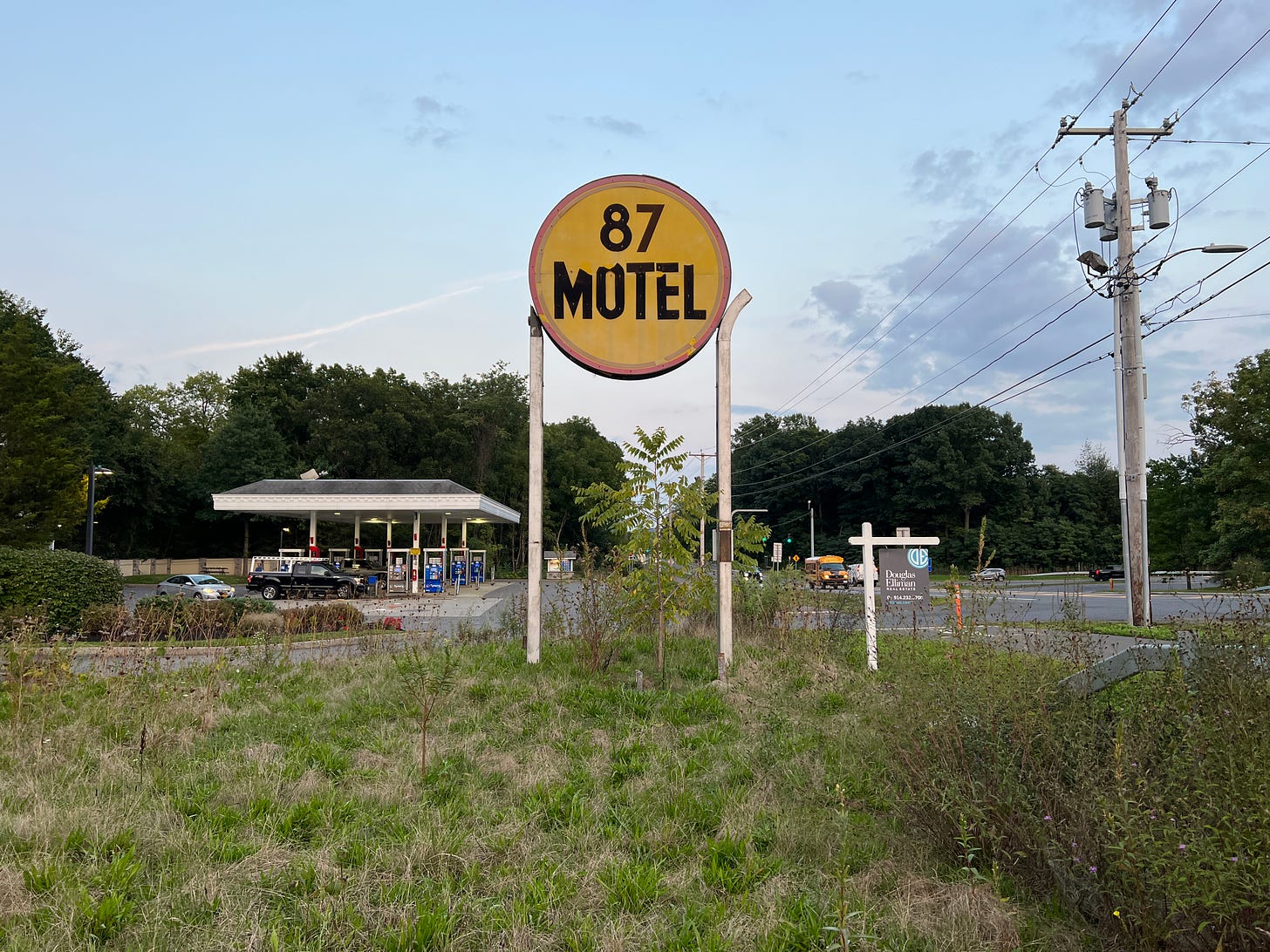Rolando's Roadside Roundup: Big Duck Edition
I visit The Big Duck, the iconic roadside attraction on Long Island; unboxing McDonald's 'Happy Meal for Adults' featuring doubled-eyed McDonaldland characters; a neon beauty in Chicago with heart
Back on a muggy August day, Brittany Winderman, my WABC-TV colleague, and I packed into a news van and headed from the bustle of 7 Lincoln Square to the countryside calm of Flanders, New York, on Long Island’s East End, where The Big Duck awaited us.
I’ve loved The Big Duck ever since I first visited it in the summer of 1996, planning a pilgrimage the moment I heard of it. It’s that way with a lot of people. They hear about The Big Duck, and they want to see it for themselves.
The Big Duck is so famous that it’s become shorthand for this kind of architecture — buildings that resemble the product they sell. Ducks and their eggs have not been sold here since the 1980s, but The Big Duck still has a belly full of ducks — on mugs, key chains and T-shirts in the gift shop inside. It also has the delightful docent Janice Jay Young, who will tell you everything you want to know about the duck, which she first visited as a child.
I invite you to click here to watch the video of our visit, and below is the story I wrote for ABC’s Localish, along with some photos I took.
The Big Duck enjoys top billing as quirky roadside attraction
At the dawn of the Great Depression, Long Island duck farmer Martin Maurer and his wife, Jeule, were on a road trip and enjoyed a cup of Joe inside a big coffee pot.
They decided, the story goes, that if the world can have a big coffee pot, then it really needs a big duck, and that they'd be the ones to provide us all with it.
And so in 1931 was born one of the quirkiest and most influential roadside attractions in American history. The Big Duck measures 20 feet tall, 18 feet wide, and 30 feet long. It's held together by a wood frame, wire mesh, white stucco cement - and 91 years of love, courtesy of countless caretakers and visitors. The duck's red eyes come from the tail lights of a Ford Model T.
This was the Great Depression, and it paid to be practical.
To say that the Big Duck remains a popular tourist destination is not to do it justice. A visit to the Big Duck isn't just a stop on a vacation itinerary or a side trip during a weekend stay in the Hamptons. Making your way to the Big Duck on Long Island's East End takes some doing. It's a pilgrimage, something people do because they hear about it and resolve to witness it for themselves.
The Big Duck was made for bucket lists.
That's what a couple and their daughter told ABC's Localish recently as they took in the splendor of the Big Duck, on Route 24 in Flanders, New York. They'd seen it in a book years ago, and now, they were finally seeing it in person.
The Big Duck is a holdover of a time when the East End had dozens of duck farms.
There's only one left today, and it's not the Big Duck. The only ducks you'll find being sold from inside its belly these days are of the souvenir variety, but the main draw at the Big Duck has long been the joyful architecture.
Visitors to the Big Duck will likely meet Janice Jay Young, but she's not just ringing up your T-shirt and mug at the cash register. Young has an encyclopedic knowledge about the Big Duck and is one of its proudest promoters. As visitors come in, and they trickle in all day, from far and wide, she's ready with a compressed but compelling history of the Big Duck.
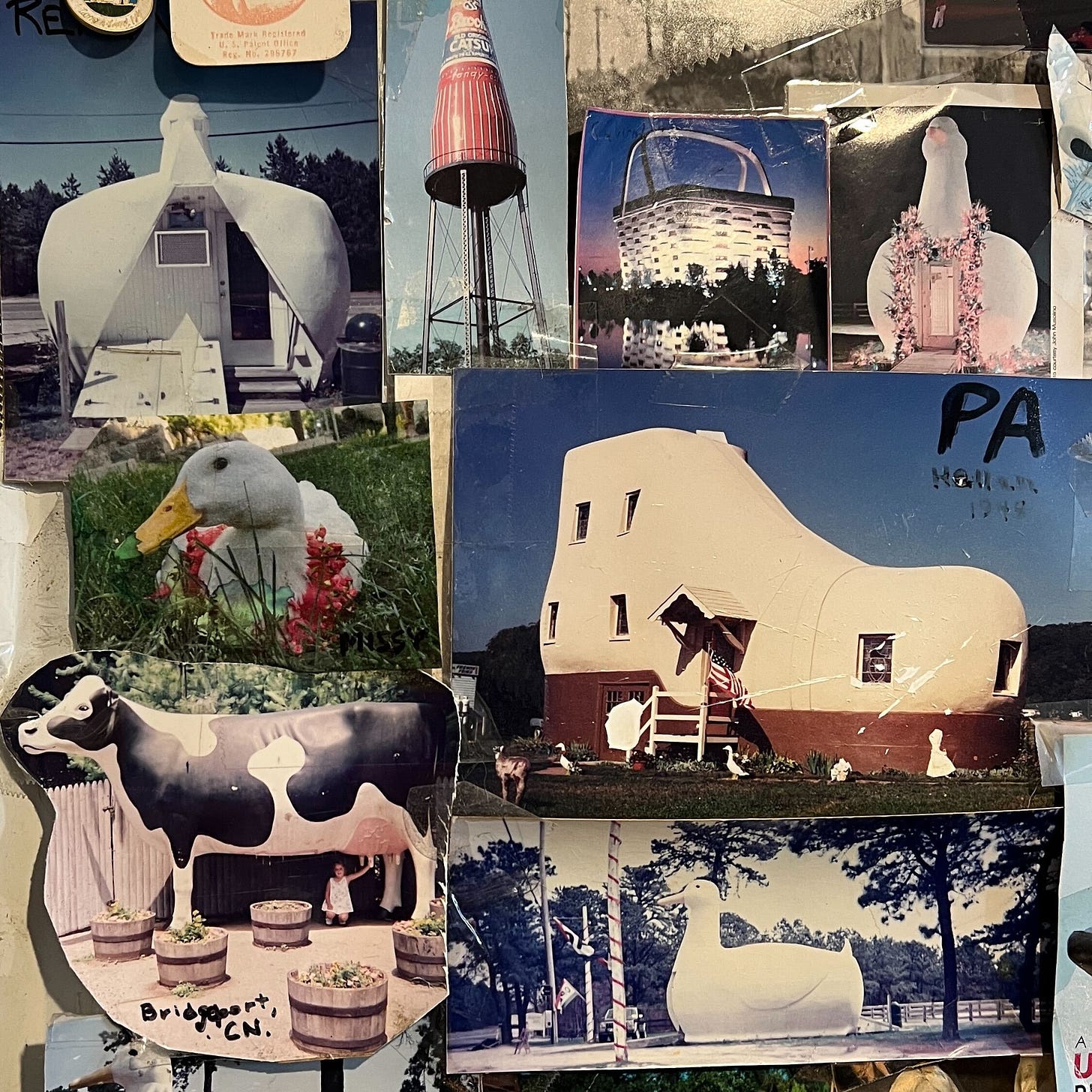
She talks about the Maurer family, who had the pluck to build the duck. She'll talk about how this peripatetic Pekin, which first settled in nearby Riverhead, moved a few times over the years, until finally nesting, presumably for good, back in its longtime home of Flanders, at the Big Duck Ranch. She'll talk about the campaign in the 1980s to save it, after the duck farm closed.
She'll point to a collage on the wall with dozens of photos, postcards and articles about other examples of programmatic architecture - those big coffee pots, big tea kettles, big fish, big ketchup bottles that sprang up across America decades ago, when road trips ruled and plane flights were for the fancy - or were still just flights of fancy.

Richard Martin, director of Historic Services at the Suffolk County Parks Department, explains the term "duck" stuck as a way of describing this kind of architecture - buildings designed to look like the product they sold, hoping to lure motorists off the road to spend a few bucks and maybe snap a picture or two.
As the owner of the duck, Suffolk County is charged with caring for it, with help from Friends of the Big Duck. The land the duck sits on belongs to the Town of Southampton, and is protected from development. People will be able to visit the duck and the surrounding ranch in perpetuity.
Young said the duck means so much more to locals here in Flanders. In this hamlet, The Big Duck is the center of their community.
"Flanders is kind of a no man's land. You know, we're the western part of Southampton Town. And sometimes we just feel a little forgotten here. So there's no bank, there's no post office, there's no Zip Code. You know, we actually have no grocery store," Young explains.
Flanders does have something nobody else has, she points out.
"We do have a Big Duck."
Unboxing The McDonald’s Happy Meal for Adults: The Cactus Plant Flea Market
The last time I’ve wanted a Happy Meal this bad was probably 1979, when McDonald’s first launched them, whipping up a frenzy among children like myself through frenetic commercials placed during, say, “Brady Bunch” reruns.
Fast forward 43 years, and I’m now an adult who was whipped into a frenzy over a Happy Meal aimed at adults, The Cactus Plant Flea Market, which for the first time in years embraces some of our favorite McDonaldland characters, with figurines of Grimace, the Hamburglar and Birdie. The box itself also features drawings of Captain Crook, Mayor McCheese, Officer Big Mac, the Fry Guys and Ronald McDonald himself.
And no, you’re not seeing double. The characters have two sets of eyes, to match the fourth figurine that’s included in the Happy Meals, Cactus Buddy, the mascot of the Cactus Plant Flea Market streetwear brand, with which McDonald’s has allied itself for this promotion. A line of swag to mark the partnership also launched on Monday, and those purchasing the meals using the McDonald’s app are entered to win free merch from the collaboration.
On my first attempt, I drew Birdie, though I was rooting for Grimace or the Hamburglar. Oh well, I’ll get my hands on the rest of them soon.
I think this is a fun campaign, a clever effort by McDonald’s to capitalize — or perhaps revive — years of marketing and good will that they’ve spent the past decade dismantling as they demolish old mansard buildings, and remove all traces of the McDonaldland characters from the stores and promotions.
It’s interesting, even frustrating, to see that the Happy Meal box features a red mansard, that architectural symbol of McDonald’s and its playful years and the antithesis of today’s cold, sterile McBoxes.
I certainly hope this collaboration and the way it plays into that McHeritage isn’t a one-off deal. We shall see.
I’m pretty sure I’ll soon be writing about another old restaurant building that bit the dust. And I’m just as sure — well, maybe not THAT sure — than in about a decade, McDonald’s will start building “retro” buildings shaped like the mansards, the same way they brought back modernized versions of the original “red and white” buildings.
The love keeping the neon sign alive for the iconic Heart O’ Chicago Motel
This story has heart.
I was so happy to read the love that is going into maintaining one of Chicago’s iconic neon signs. Chicago Magazine talks to Scott DeGraff, the son of the founder of the Heart O’ Chicago Motel in Edgewater, which opened in 1957.
He told the magazine that he travels to Las Vegas for replacement parts for the sign that has become a symbol of sorts for Chicago.
Here is my photo of the sign from a visit a few years ago.
Sign Spotlight: 87 Motel
The 87 Motel, off the New York State Thruway (Interstate 87) in New Paltz, is long gone. The motel in its final days earned poor reviews and the state of the buildings earned it the lethal label of eyesore.
It’s been a while since there’s been an update about the property’s fate, but for now, the old 87 Motel sign is still standing. I forged through some weeds to take this photo of it the other day.
I remember, during long-ago weekend trips to the area, when this sign would light up at night. It hope it doesn’t end up trashed like the rest of the motel.
Later this week
Tuesday is National Taco Day, so I’ll have some nostalgic bites, from vintage Taco Bells to some mom-and-pop stands.
On Wednesday, I’ll be publishing my guide to Pizza Hut Classics, the most comprehensive list out there. Maybe there’s been one near you all along.
If you enjoyed this and haven’t subscribed to my newsletter, please do. There are multiple tiers, including paid, all of which will go to support my mission to document these places, and enhance your enjoyment and appreciation of them. Your support is appreciated!


